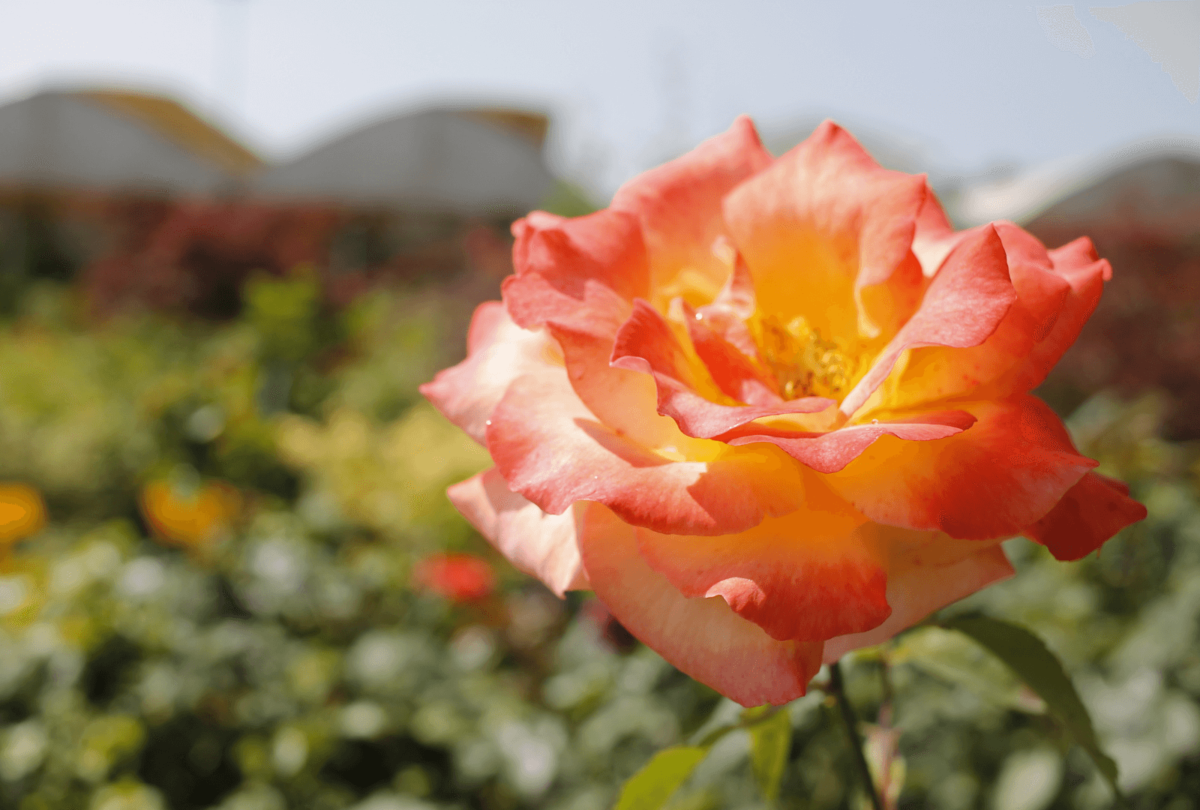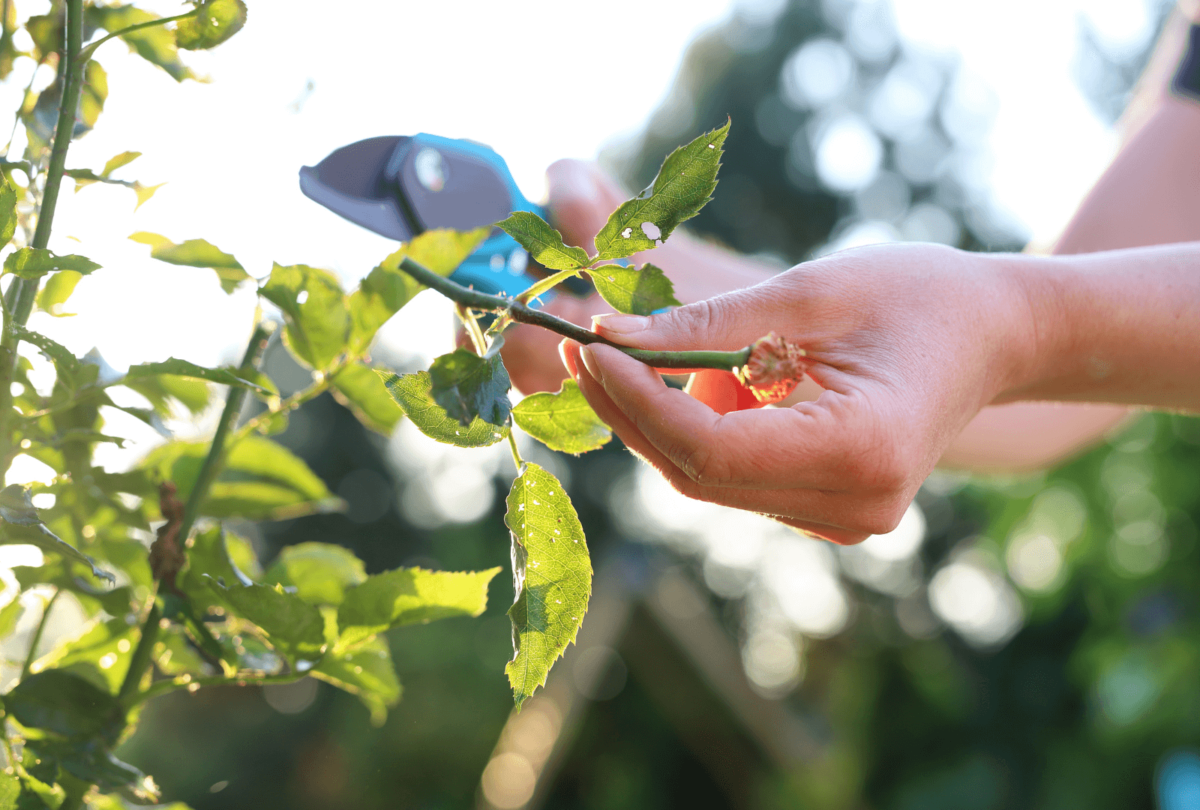Roses are an extremely attractive addition to any garden, and in order to maintain their beauty and many years of wonderful blooms, it’s important to ensure that all dead wood, stumps at the base of the plant and any diseased material is cut away. Not only will you foster a healthy rose plant, but you will have time for self-meditation, reflection and feel a great feeling of accomplishment when you are done.

Table of Contents
Why Pruning is Important
Pruning standard roses is important so that you can establish an attractive shape. By cutting two thirds of the main stems and tidying up the central area in the first year the basis for future years will be established and pruning in future years will follow the original shape.
Before pruning, decide which way you want the shoot to grow. This would normally be outward facing as it opens up the bush and ensures light reaching all parts of the rose. An angled cut just above a bud that is facing outwards will give you the shape you’re looking for, but make sure the highest side of the cut is above the bud to prevent water from remaining in the bud itself which will cause it to rot. Care at this time will make the difference between a pleasing shape and one which is growing in different directions.

If you want your bush roses, standards or climbers to retain their natural shape, then pruning is not necessary. They will generate a great deal more foliage and require very little maintenance, i.e., pruning once a year to remove dead wood. However, it should be noted that they will not produce as many flowers as all their energy will be put into creating the foliage.
How to Prune A Rose Bush
Pruning roses can be done in either autumn or early spring, although in the first year of growth you should not prune shrub roses, climbers or miniatures.
In order to get the very best out of your rose garden and prevent root rot, it’s important to remove all dead, diseased, damaged or broken wood. It’s also essential to remove suckers which originate from the rootstock, and grow up from the base of the plant below the graft union. Suckers take away the nutrients from the plant so it’s important to cut them off below the union.
In order to remove suckers successfully, it’s necessary to dig around the base of the plant to find where the sucker is attached to the main plant. By cutting as close to the stem as possible and then carefully replacing the earth you will have hopefully prevented the sucker from growing again. Always water well after carrying out this operation, and ensure the rose is firmly embedded in the soil.

As blooms fade remove them as they are a nesting ground for pests. By cutting off the dead flower level with an opening bud, you are allowing the stems to put all their energy into producing healthy flowers. Dead heading is necessary with most plants as it means you are prolonging the flowering season, and constantly revitalizing your plant’s energy levels.
In the case of cluster flowering roses, removing individual flowers as they fade is still necessary, and eventually when all the flowers in the cluster have died you can cut off the whole cluster in the same way.
If you want to produce larger flowers, this can be done by removing all the buds that are close to the main bud. This will encourage the plant to provide the main bud with more nutrients giving an extra large bloom. This does mean of course that you will have less flowers on the plant, but those that are produced will be magnificent. This procedure should only be carried out on fairly established roses that have been producing strong healthy stems for a few years.
If you’re interested in training a rose into a standard the plant should be staked during the first two years to establish a good shape and stability. The main stem should be de-budded on a regular basis allowing the flow of energy to be directed upwards towards the main flowering area.
Dead heading roses prevents hips forming, but if you want to produce rose hips then dead heading is not necessary. Hips do however take away energy from the flowers which will more than likely lead to a shorter flowering season.
If you have a newly planted rose bed it’s not necessary to provide a fertilizer until after they have produced their first flowers. In an established flower bed roses should be fertilized in early spring and then approximately every four to five weeks during the summer. This will ensure healthy and productive plants.
After pruning your roses, a nitrogen rich fertilizer will provide the energy needed to create prolific bud formation, giving you the desired results throughout the growing season. Remember to always water the roses well before applying fertilizer, and indeed ensure they are kept watered during dry period. A hot dry period followed by rain can be disastrous for roses, so try to maintain a proper balance and they’ll be virtually trouble free.
A rose garden provides color and perfume and gives a luxurious setting for any garden. Tend them well, and they’ll not disappoint. In fact you’ll derive much pleasure for many years to come.
- About the Author
- Latest Posts
I strive to paint vivid landscapes with my words, bringing the magic of far-off lands and enchanting aromas to life for my readers. Combine passion for exploration and the art of gastronomy in an unending ode to the senses. When I’m not traversing the globe, I find solace in the earth beneath my fingertips, tending to my garden and working on projects around my verdant oasis. MK Library serves as a beacon, guiding fellow travelers and homebodies alike to embrace sustainability, nurturing both our planet and our souls with purpose. Full Bio.

